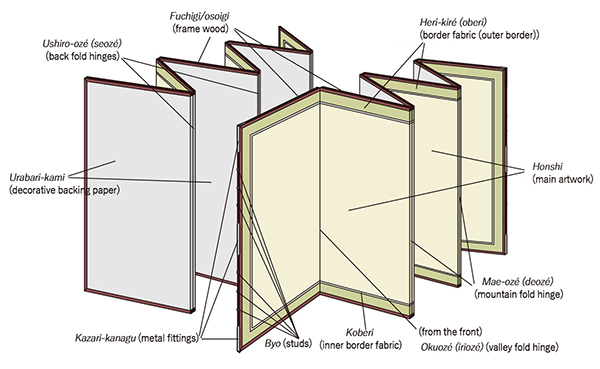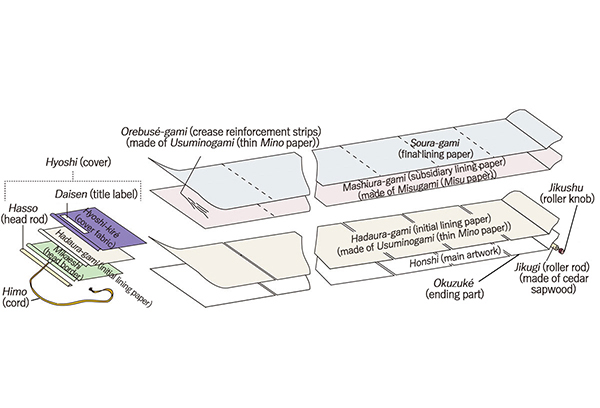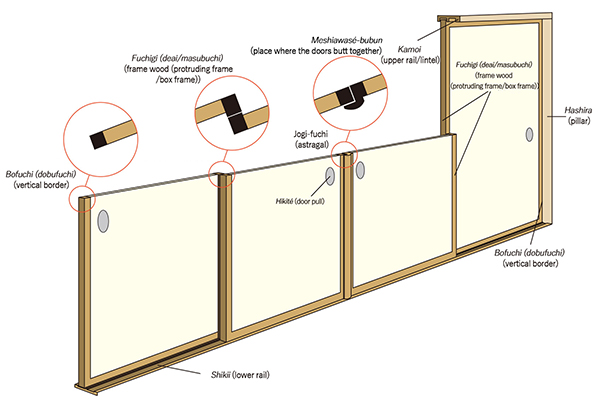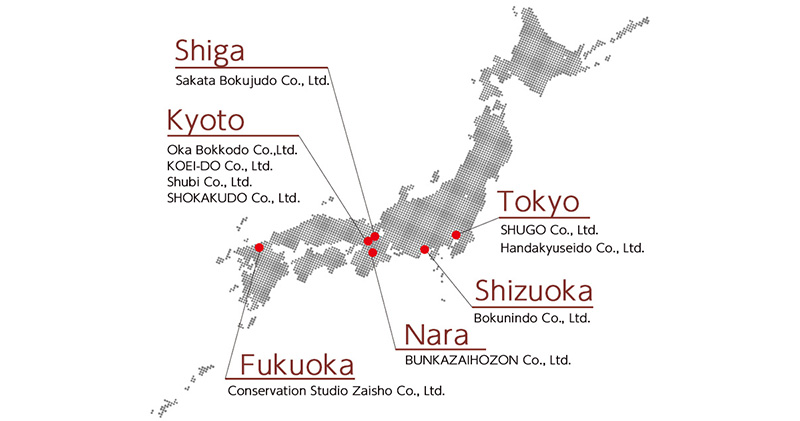The need for conservation
Japan is home to countless cultural properties dating back many centuries, with some originating over 1,000 years ago. Most are not archeological artifacts, but were passed down from person to person over all those years. Despite the fact that the vast majority of them are made of fragile materials like silk and paper, they have survived so long thanks to timely, repeated conservation efforts.
Painstaking efforts have been made to ensure the survival of these cultural properties to date, and careful conservation must continue if they are to survive for future generations.
What is the meaning of soko?
The term soko, from the Japanese name for the ACNT, dates to ancient times. It appears in documents from the Nara period (710 – 784 CE) and on sutra scrolls from the Tang dynasty (618 – 907 CE). Apparently, the term referred to the work of dyeing, cutting, aligning and joining, and otherwise processing Japanese paper used for mounting sutras and other written works.
Since our founding in 1959, we have added a new meaning to the word soko which is cultural properties—namely, Japanese and East Asian paintings, calligraphies, and other works of art comprised mainly of paper and silk. We also continue to coin, use and promote new Japanese words that contain the term to describe restoration techniques for mounted cultural properties, soko shuri gijyutsu, and conservators, soko-shi, who employ these techniques. In 1995, restoration techniques for Japanese paintings and calligraphies became nationally designated as Selected Conservation Techniques, and since then have gained recognition in Japan and around the world.
The Soko cultural properties—the focus of our conservation efforts—refer to paintings and calligraphies in the traditional formats of Japan and East Asia. Most are rendered with ink, colored pigments, or dyes on paper, silk, or wood, and mounted as handscrolls, hanging scrolls, sliding doors, folding screens, framed pictures, partitioning screens, booklets, and picture albums.
Ryo no gigé (Commentary on Governmental Decrees), Law stipulating the duties of ministries, Bureau of Drawings and Books, article
Structure of mounted cultural properties
Most mounted cultural properties can be separated into two parts: honshi, the artwork on which the words and images are painted or printed, and sotei, the decorative mounting that protects the honshi. Through restoration techniques for Japanese paintings and calligraphies, honshi are carefully removed from sotei, any damage-causing factors are removed, and weakened places are stabilized with reinforcements or filler materials before the honshi and sotei are reassembled.
-
Structure of a kakejiku (hanging scroll)
-
Structure of byobu (folding screens)
-
Structure of a kansu (hand scroll)
-
Structure of fusuma (sliding doors)
What conservation involves
Principles and ethics of conservation of Japanese Paintings and Calligraphies
Conservation is the precarious act of taking apart frail cultural properties and meticulously restoring them. When cultural properties reach the point where they require conservation, we must use minimally invasive methods to preserve their value.
The principles listed to the right guide our earnest efforts to conserve cultural properties. The underlying concepts grew out of our experience in the conservation of cultural properties over the years, and also comply with the Act on Protection of Cultural Properties.
The principles serve as ethical guidelines for our conservation technicians, who carry out their work with exacting precision after conferring extensively with experts and the owners of the cultural properties.
- ・Maintain the informational content and inherent value of each cultural property
- ・Add no lines, coloring, marks or any other alterations
- ・Remove damage-causing factors and impediments to preservation
- ・Repair and filler materials must not impede preservation or appreciation of the cultural property
- ・Honshi (artwork) must be distinguishable from infilled areas
- ・Materials and techniques used must be conducive to subsequent conservation efforts
- ・Document all conservation policies followed, investigations performed, and treatments and materials used
*These principles represent our approach to restoration at this time and are subject to change as we search for and discover better solutions.
Conservation techniques
Restoration Techniques for Japanese Paintings and Calligraphies
We developed our restoration techniques by focusing on the conservation component of the traditional skills used by professionals in Japanese mounting. Conservators continue to study and improve techniques based on the strength of scientific evidence, scholarly knowledge, and globally recognized ethics for protecting cultural properties. The very existence of cultural properties speaks to the validity of the traditional techniques that were used to restore them multiple times over centuries. We add the findings of modern science to proven traditional techniques to develop proprietary restoration techniques for Japanese paintings and calligraphies.
To preserve the inherent value of cultural properties for future generations, we must practice proven conservation techniques and consider the shapes, textures, styles, uses, and other qualities the cultural properties have conveyed through history.
Selected Conservation Techniques
Selected Conservation Techniques are traditional techniques for the conservation of cultural properties designated by the Agency for Cultural Affairs. ACNT is an approved group that preserves Selected Conservation Techniques.
Accordingly, we receive subsidies to hold workshops, cultivate and train conservators, create records, and develop other projects.
Examples of conservation
-
Matsutaka-zu Painting in color with gold leaf and paper, mounted as sliding doors, Ninomaru Palace at Nijo Castle (Important Cultural Property, Kyoto city)
-
Bound document, Hokkaido Development Commissioner (Important Cultural Property, Hokkaido Prefectural Government)
-
Satake-bon Sanjurokkasen-giri (Section of the Portraits of 36 Poets handscroll, former Satake clan collection), image of Fujiwara no Motozane, colors and ink on paper, mounted as a hanging scroll (Important Cultural Property, Agency for Cultural Affairs)
-
Byakko (White Tiger), Fragment of a wall mural, Kitora Tomb (National Treasure, Agency for Cultural Affairs)











